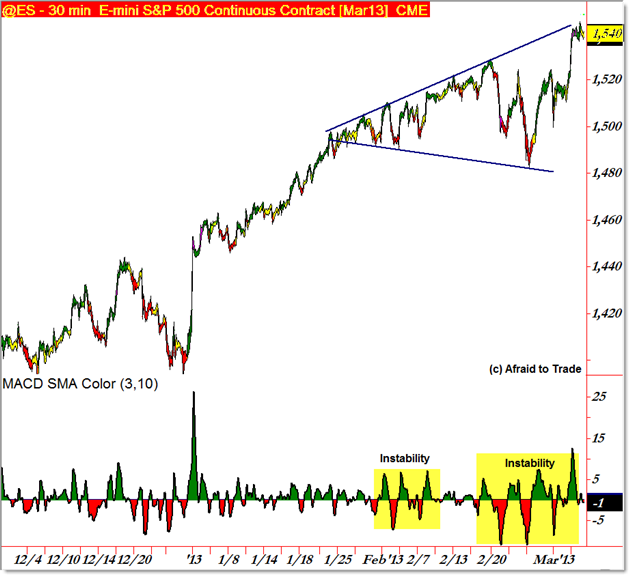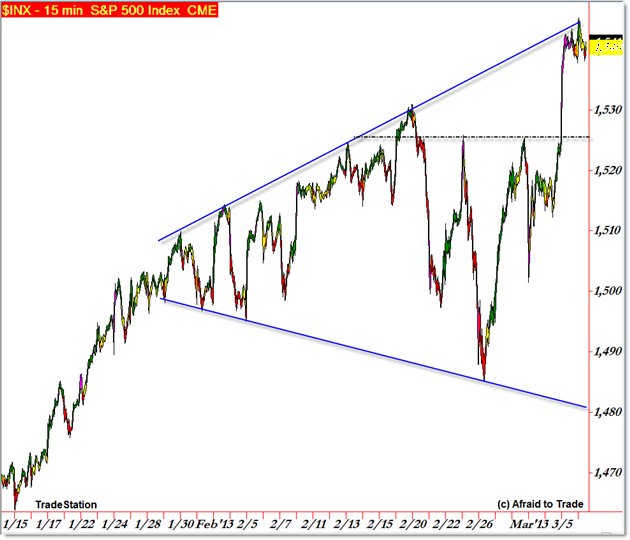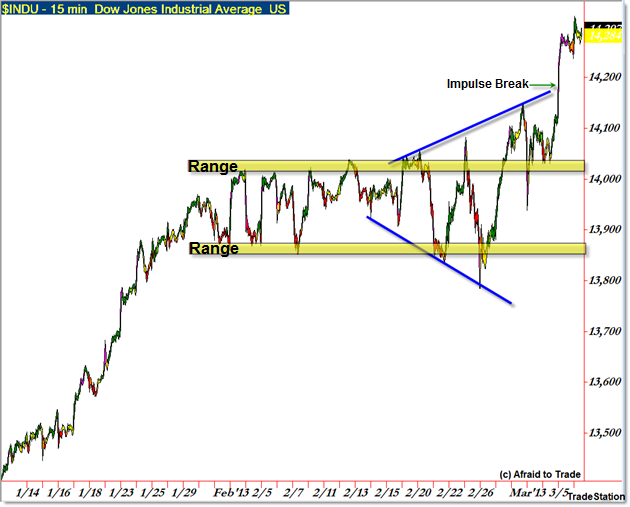March 6 Structure Triangle and Breakout Update on SP500 and Dow Jones
The S&P 500 continues to trade within a well-defined broadening triangle pattern while the Dow Jones broke above a key rectangle resistance pattern along with a smaller triangle pattern, according to market structure.
Let’s view the Triangle Boundaries on the S&P 500 along with the updated ‘breakout impulse’ structure on the Dow Jones.

The broader 30-min intraday chart shows not just the current triangle/broadening pattern, but also the progression in structure that brought us to this point.
I also highlight the two recent periods of market instability (violent, noisy swings in both directions) which characterizes the current short-term environment.
While we can view the broader perspective above, let’s focus our attention on the trendline boundaries:

Starting with the latter part of January, we see a stable increase in volatility marked by reversals at expanding trendline boundaries.
In simple terms, this resembles a “Broadening Formation” or expanding trendline pattern and it’s contained the price movement from February to present.
The key now will be how the market reacts to the current upper (heightened) boundary into the 1,545 level.
If the pattern continues, the next move would be expected to be a sharp retracement lower that would initially target the breakout zone or horizontal trendline (‘neckline’) into 1,530.
A movement beneath that simply targets progressively lower support targets such as 1,500 and then 1,480.
The alternate play would be for a powerful impulse higher that creates a feedback loop in the event sellers exit the market (capitulate), resulting in a powerful short-squeeze and one-sided dominance from demand (buyers).
That is similar to what happened on the breakout recently in the Dow Jones Index:

When compared to the S&P 500 Index, the Dow Jones showed a more subdued, horizontal rectangle pattern stretching throughout February which gave-way to its own expanding trendline (broadening) formation.
The breakout above the 14,200 level (the “All Time High” in the index) resulted in that capitulation impulse from the bears/short-sellers which joined with buyers willing to pay-up to enter a breakout market.
If we extend the upper trendline, it intersects the 14,200 ’round number’ level which would be an initial target on any pullback/retracement from the “Open Air” levels where the index resides.
Remember, there is no resistance when the market is at new all-time highs. There’s only support levels and the interplay whether buyers step-in to buy retracements or else step back and take profits (or liquidate losses) in the event expected support levels fail.
With structure in a ‘noisy’ and volatile/chaotic mode, do be extra careful and remain on the lower-frame charts if possible which allows for quicker action/reaction to real-time developments in a newly volatile stock market that’s awakened from complacency.
Corey Rosenbloom, CMT
Afraid to Trade.com
Follow Corey on Twitter: http://twitter.com/afraidtotrade
Corey’s new book The Complete Trading Course (Wiley Finance) is now available!

2 Comments
Comments are closed.